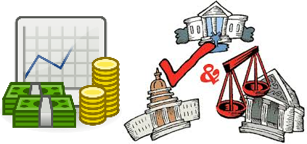In the discussion of government subsidies, the idea of "free stuff" is scrutinized under the premise that there is no such thing as a free lunch. Every subsidy, whether for individuals, businesses, or institutions, comes with a cost that ultimately must be borne by taxpayers. The central objective of subsidies is to encourage economic growth, support specific sectors, or assist individuals in need, often through various forms of financial assistance like cash payments and tax breaks.
What Are Subsidies?
A subsidy is a financial benefit provided by the government to individuals or businesses to promote a desired economic activity. These benefits can take many forms, including direct cash payments, tax incentives, and support for struggling industries or geographic areas. The government aims to stimulate growth, support innovation, and address social issues through these subsidies.
The Flow of Taxpayer Money
The process of funding subsidies involves collecting taxes from citizens, which is then funneled through government mechanisms to support various programs. While this may seem inequitable—taking from one group to benefit another—there is a general consensus that pooling resources allows for collective support of societal needs. Ideally, if government spending were managed wisely, taxpayers might not object to the redistribution of their money.
However, the reality is that government efficiency is often questioned, leading to debates about whether taxpayer dollars are being spent responsibly. A significant concern arises when the funds allocated to aid individuals or businesses do not result in positive societal outcomes. The discussion highlights that taxpayers often feel frustrated when they see funding being mismanaged or misused.
The Supplemental Nutrition Assistance Program (SNAP)
One prominent example of a subsidy is the Supplemental Nutrition Assistance Program (SNAP), which provides electronic benefits to help individuals purchase food. While the program aims to prevent hunger, it indirectly benefits farmers, as the funds are used to buy food products. However, taxpayers bear the financial burden of funding these programs without direct benefits for themselves.
This raises important discussions about the ethical implications of government spending, especially when recipients of subsidies are seen purchasing non-essential items with their benefits. The debate continues on whether taxpayers should be concerned about how welfare funds are utilized and whether this affects their willingness to support such programs.
The Cycle of Government Spending
The government collects tax revenue but often falls short of the funds necessary to cover all promised subsidies. To bridge this gap, it borrows money, leading to national debt that future generations must repay. This creates a cycle of borrowing and repayment that can result in higher taxes in the future. The video emphasizes that, while some may benefit from free services today, they will inevitably pay for them in the long run.
The Trade-Offs of Subsidies
The discussion introduces a hypothetical scenario of two contrasting societies: one where everything is free and another where nothing is free. In a world where everything is free, the incentive to work diminishes, leading to a lack of production and economic stagnation. Conversely, a society where everything must be paid for encourages hard work and competition, which can foster innovation and economic growth.
The video argues that both extremes present significant problems. A balance must be struck between providing necessary support for those in need and maintaining productive incentives for the workforce. This middle ground acknowledges that while some subsidies are essential, they must be managed carefully to avoid creating dependency or discouraging work.
Who Decides on Subsidies?
Ultimately, it is the government that decides who receives subsidies and who does not. This decision-making process is influenced by political ideologies and the electorate's preferences. Voters have the power to change their representatives based on their opinions regarding subsidy allocation. The continuous cycle of elections reflects citizens' desires for different approaches to economic support and welfare.
Conclusion
The key takeaway from the discussion is that while subsidies can provide valuable support to individuals and businesses, they come at a cost that must be borne by taxpayers. The complexity of government spending, the ethical considerations surrounding the use of subsidies, and the need for a balanced approach are crucial points for understanding the broader implications of financial assistance programs. It serves as a reminder that in the realm of economics, every action has a reaction, and careful consideration is required to ensure that support systems work effectively for both the recipients and the taxpayers funding them.
Summary of "Free Stuff: Government Subsidies"
Introduction to Free Stuff
No such thing as a free lunch; everything has a cost.
Focus on the costs associated with subsidies.
Definition of Subsidies
Benefits provided by the government to individuals, businesses, or institutions.
Aim to encourage specific economic activities or support those in need.
Types of Subsidies
Can include cash payments or tax breaks.
Designed to support struggling sectors of the economy or promote social good.
Taxpayer Contributions
Taxes fund subsidies, leading to a redistribution of wealth.
Taxpayers do not directly benefit but help those in need.
Government Spending and Accountability
Ideal scenario: government effectively redistributes taxes to benefit the greater good.
Reality: often inefficient spending leads to taxpayer frustration.
Impacts of Subsidies
Focus on programs like Supplemental Nutrition Assistance Program (SNAP) and EBT cards.
Indirectly benefits farmers as recipients purchase food.
Taxpayer Perspective
Taxpayers bear the cost without receiving direct benefits.
Concerns arise over how government funds are spent (e.g., purchasing unhealthy food).
Government's Role in Spending
Government must make decisions about how to allocate funds.
Citizens have the power to influence these decisions through voting.
Trade-offs in Subsidies
Discussion of the balance between providing free services and the necessity for work.
Societal implications of either extreme (all free vs. no free).
Examples of Subsidies
Free school lunches and healthcare programs funded by taxpayer dollars.
Taxpayers pay for their own needs while funding these programs.
Conclusion
Emphasis on the reality that nothing is truly free; costs are always incurred.
Acknowledgment of the ongoing debate about the fairness and effectiveness of government subsidies.


